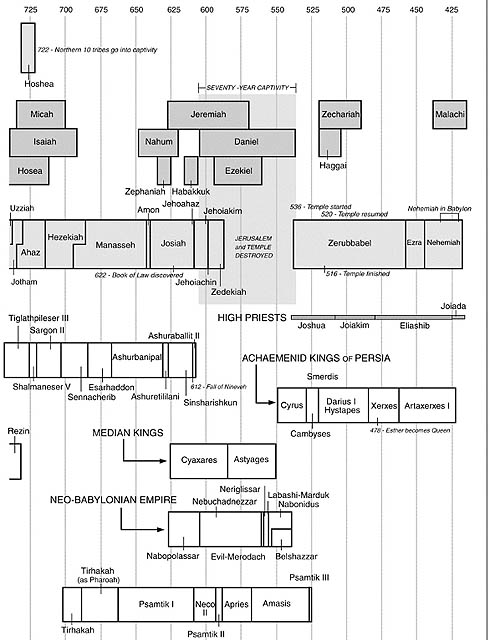The writing prophets of the OT fall into two groups: the 4 major prophets—Isaiah, Jeremiah, Ezekiel, and Daniel—and the 12 minor prophets—Hosea, Joel, Amos, Obadiah, Jonah, Micah, Nahum, Habakkuk, Zephaniah, Haggai, Zechariah, and Malachi. Lamentations falls into the major-prophet grouping because of its connection with Jeremiah.
Besides these, the OT regarded others as prophets. Such prophets as Gad, Nathan, Elijah, and Elisha were typical of the nonwriting prophets. In a sense, John the Baptist as a forerunner of Jesus was a prophet who belonged to the OT era.
The following table gives the sequence and approximate dates and direction of ministry for the writing prophets, with “Israel” designating the northern kingdom and “Judah” the southern:
Another way of categorizing the writing prophets relates them chronologically to the captivities of Israel (ca. 722 B.C.) and Judah (ca. 586 B.C.):
Messages of the writing prophets sometimes related to the prophets’ immediate future (e.g., Is. 7:1-11) and sometimes to the distant future (e.g., Is. 7:12-14). In their frequent predictions about the coming Messiah, they saw Him in two roles: that of a suffering Messiah (e.g., Is. 53) and that of a reigning Messiah (e.g., Is. 11). The prophets themselves were unable to comprehend completely how these two aspects of the Messiah’s future ministry would fit together (1 Pet. 1:10-12).
God’s dealings with Israel dominated the pages of the major and minor prophets, but several books—Daniel, Obadiah, Jonah, and Nahum—have as their subjects God’s working in Gentile world history. The other prophetic books look beyond Israel from time to time to note how God’s chosen nation will impact the rest of the nations (e.g., Is. 52:10, 15) or how God will judge the nations.
As seen from the chronological listing on the previous page, the period of the writing prophets ended about 400 years before the coming of Christ. No official declaration marked the end of OT prophecy, but the people of Israel came gradually to the realization that no prophet had appeared in Israel for a considerable period of time (cf. 1 Macc. 9:27). From the perspective of later times, it became obvious to all that the great prophetic movement of the OT terminated and thus commenced the 400 “silent years,” after which comparable written ministries of NT apostles and prophets began.

